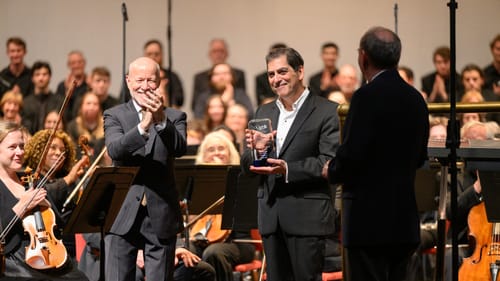Stay in the Loop
BSR publishes on a weekly schedule, with an email newsletter every Wednesday and Thursday morning. There’s no paywall, and subscribing is always free.
A Beethoven farewell
Delaware Symphony Orchestra presents Amado Conducts Beethoven

To cap his 20th season as music director, and close the Delaware Symphony’s 117th season, David Amado chose Beethoven. The maestro feels strongly aligned with this composer, evident in an emotional and celebratory concert.
The evening opened with Symphony No. 8 in F Major (Op. 93), a lesser-played work that premiered in 1812 to a lukewarm reception. Amado noted that Beethoven’s peer Carl Czerny (of that familiar piano exercise book) asked the composer why No. 8 was not as popular as previous works. Beethoven (who conducted the premiere) responded, “Because it is a better piece!”
The Haydnesque work is one of Beethoven’s few symphonies in a major key, each of its four sections a kind of stand-alone scherzo. The first and third movements are in three-quarter time, and while the third is the indicated tempo di menuetto, the opening movement is equally buoyant.
Amado has conducted this symphony only once before and it was new to the orchestra. So while it was not a highly polished performance, it had a welcome freshness not always heard with Beethoven’s more familiar works. The conductor clearly enjoyed its lightness and grace, conducting with verve and forward motion. The difficult clarinet solo in the “call and response” third movement was rendered with style and the fourth movement (beginning with string tremolos reminiscent of Mendelssohn) ends gleefully with final chords that could only be Beethoven.
Majesty and song
After intermission came the work that brought much of the audience to the Grand on a rainy spring evening: Symphony No. 9 in D minor (Op. 25), subtitled “Choral” for the vocal section of its fourth movement. It was written between 1822 and 1824, when it premiered in Vienna. Here, Beethoven, a devotee of German poet and philosopher Friedrich Schiller, musically states his own beliefs, most overtly in the Finale’s famous setting of the poet’s An die freude (Ode to Joy).
The symphony’s familiar dramatic opening leads into a majestic first movement shifting constantly between light and dark. The second movement is labeled Molto vivace—though it could hardly be more vivace than the first—and here (as elsewhere) Amado skillfully tailored Beethoven’s exciting, dramatic silences.

The third movement, Adagio molto e cantabile, is truly songlike, its sublimely sweet, serene writing for strings beautifully realized by the orchestra. During this movement, something occurred that could only happen in a live concert: suddenly, a breath of cool air swept through the hall, a perfect physical manifestation of the music emanating from the stage.
Enigmatic and embracing
Before the Finale, a rustle of anticipation swept through the audience. The movement begins with an orchestral prelude to preface the work’s iconic tune, which begins in the low strings and sweeps through the orchestra section by section. There’s a jaunty janissary segment (Turkish marches were popular at the time), and then comes the choral portion, introduced by the bass soloist (Matthew Burns) as Beethoven speaks directly to the audience: “Oh friends, no more of these songs! Let us sing more cheerful songs, more full of joy!”
Then a soloist quartet (Burns, soprano Mary Wilson, mezzo Clara Osowski, and tenor Thomas Cooley) alternated with the 100-plus voices of the University of Delaware Symphonic choir (difficult to hear clearly from their position behind the orchestra) in one of the most iconic pieces in the classical repertoire. This fourth movement (almost a symphony in itself) lasted 30 minutes, the length of the entire work on the first half of the evening’s program.
The familiar Finale is also enigmatic, its embracing poetic text contrasted with Beethoven’s forceful music. Throughout, Amado admirably kept the orchestra in forward motion, never commenting or descending into sentiment. The ninth symphony has been lauded since its very first performance, when the audience gave Beethoven a riotous standing ovation. The deaf composer, who was conducting, was turned around by a soloist so he could see the exuberant crowd, and the piece evoked the same response on Friday that it did 200 years ago.
A distinguished living American conductor
This evening was a concert and an event, the sold-out house there to congratulate and celebrate Amado, who now becomes the symphony’s first-ever Music Director Laureate. In recognition of his two-decade tenure, among the evening’s applause and accolades was a very specific one: Amado received the symphony’s prestigious Alfred I. duPont Award.

As well as breaking new musical ground, composers also create works reflecting the audiences and styles of their times. In 20 years as music director, Amado has sought such a balance, programming contemporary works juxtaposed with the arc of history from which they spring. The A.I. duPont award has been given annually since 1986 to “a distinguished living American composer or conductor who has made a significant contribution in the field of contemporary classical music,” and at this concert, Amado joined the ranks of its honorees.
What, When, Where
Amado Conducts Beethoven. Beethoven; Symphony No. 8 in F Major (Op. 93) and Symphony No. 9 in D minor (Op. 125, “Choral”). Conducted by David Amado. Delaware Symphony Orchestra, with Mary Wilson, Clara Osowski, Thomas Cooley, Matthew Burns, and the University of Delaware Symphonic Choir. April 28, 2023, at the Grand Opera House's Copeland Hall, 818 N Market Street, Wilmington. (302) 656-7442 or delawaresymphony.org.
Accessibility
The Grand’s Copeland Hall is wheelchair-accessible, and assistive listening devices are available.
Masks and proof of vaccination are not required.
Sign up for our newsletter
All of the week's new articles, all in one place. Sign up for the free weekly BSR newsletters, and don't miss a conversation.

 Gail Obenreder
Gail Obenreder